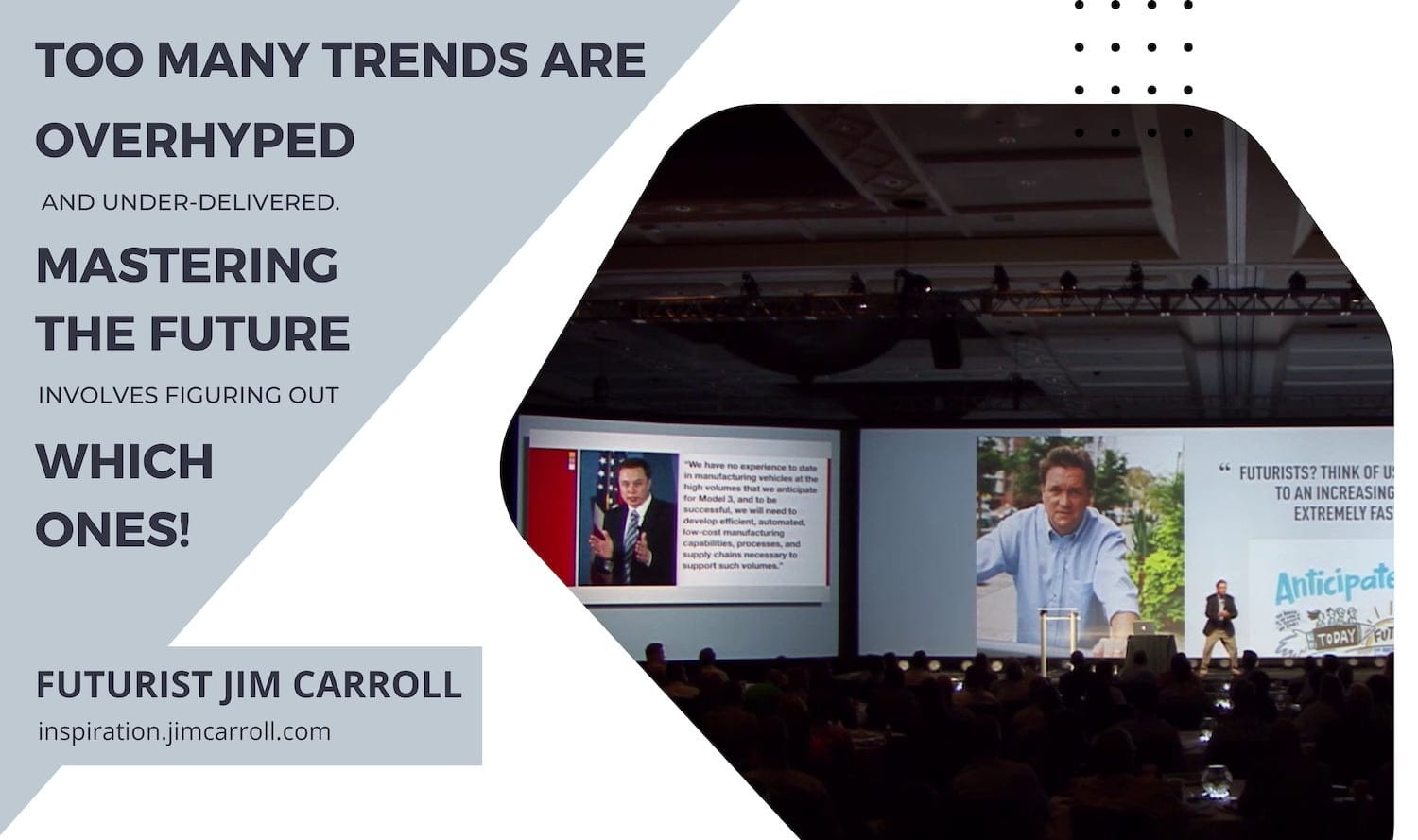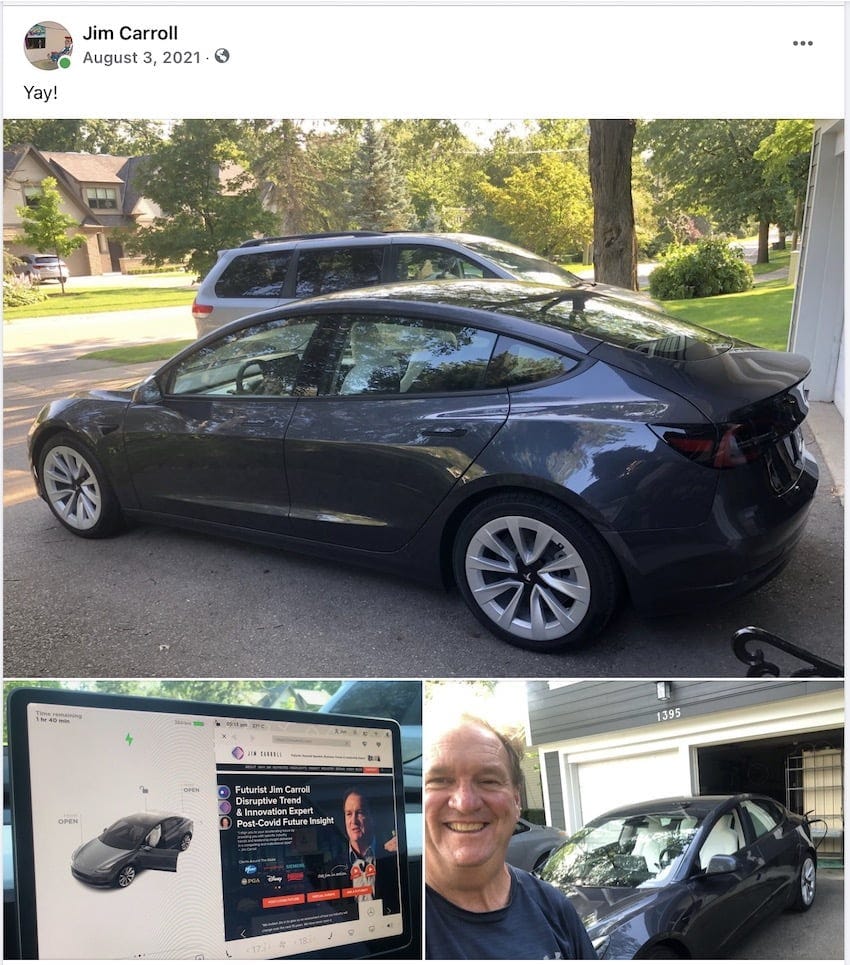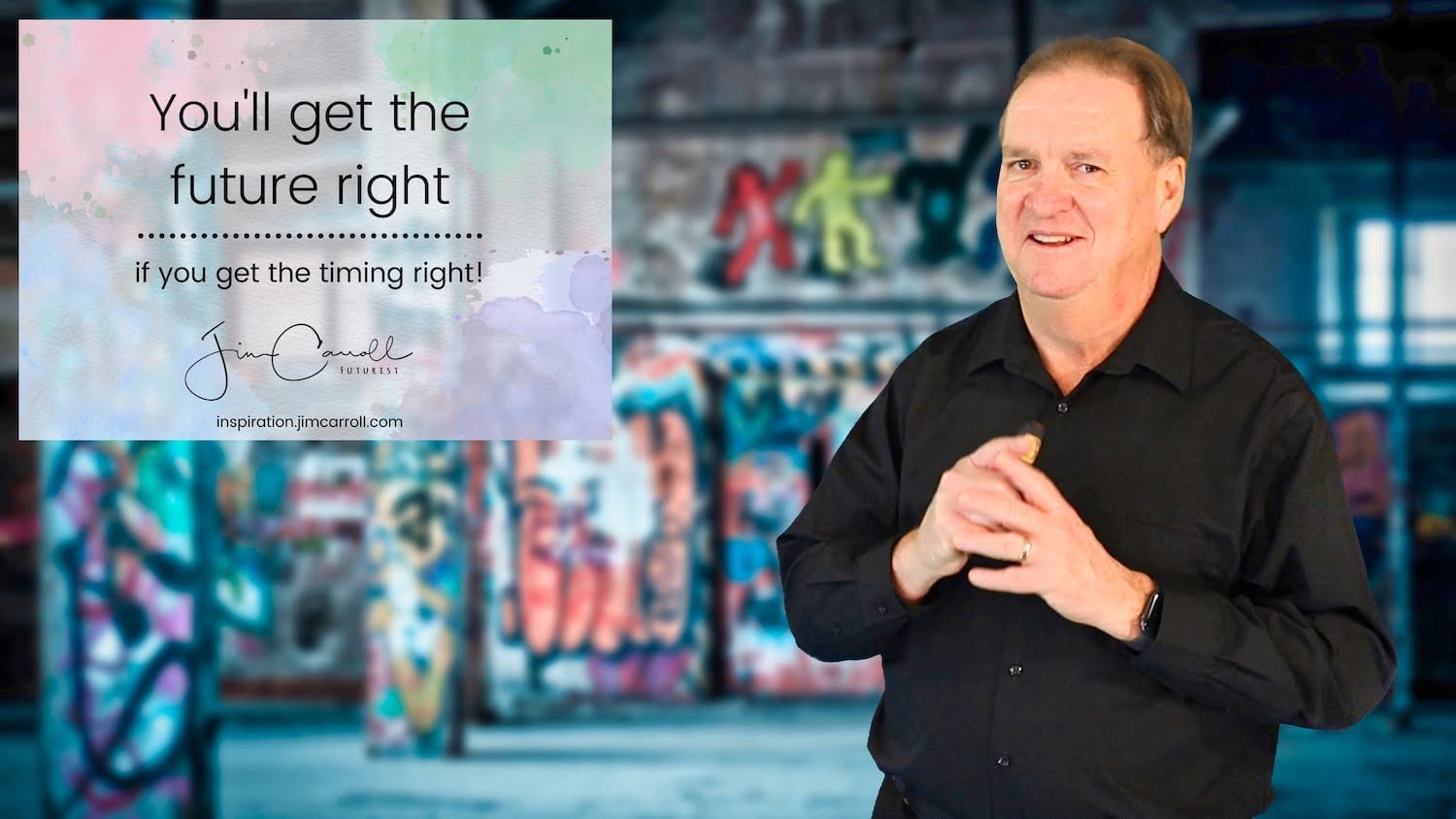"Too many trends are overhyped and under-delivered. Mastering the future involves figuring out which ones!" - Futurist Jim Carroll

I love my Tesla. But as you know, I'm no longer a big fan of the founder.
And I've become massively skeptical of the potential for self-driving cars - indeed, I suspect that I got both the timing and sophistication of the trend wrong. I've known this for some time; last August, I filmed a video and filmed an overview titled It's Not the Trend That Matters, It's the Timing! (Real 'Self Driving' Isn't Here, and Won't be For a Long, Long Time!). You can read the post here, and I share it again below.
Obviously, I was a big believer in the potential for self-driving technology, by writing such trends overviews as 54 things you haven't thought about with electric, self-driving cars. Yet, owning a Tesla with FSD ('full-self driving', which it obviously is not) makes you quite jaded on the potential for the trend. What's the basis for my reversal? Experience - as I note below, while what is there is a massively impressive technical feat, getting it to 100% reliability will likely never happen in my lifetime - and that is what is necessary for it to succeed. It's not "full" self-driving. It's "self-driving sometimes in known, predictable conditions."
Others are picking on this; just yesterday the Washington Post ran a rather pointed article on how Tesla is failing to deliver on the lofty promises set in years past:
In April 2019, at a showcase dubbed “Autonomy Investor Day,” Musk made perhaps his boldest prediction as Tesla’s chief executive. “By the middle of next year, we’ll have over a million Tesla cars on the road with full self-driving hardware,” Musk told a roomful of investors. The software updates automatically over the air, and Full Self-Driving would be so reliable, he said, the driver “could go to sleep.”
How Elon Musk knocked Tesla’s ‘Full Self-Driving’ off course
Washington Post, March 19, 2023
That clearly didn't happen, and it is far, far away if it were to ever happen. The debate has been raging for quite some time, with other publications such as the New York Times and The Guardian weighing in for quite a while on the problems with the technology. This is a painful reality for the many Tesla 'fanboys' as we call them. Yet even they are losing faith:
And some of Musk’s most loyal customers have given up hope that his initial promise will come true. Charles Cook, a commercial pilot, and engineer from Jacksonville, Fla., owns a Tesla Model Y that he frequently drives in Full Self-Driving mode.
While he is amazed at what the technology can do, he is surprised by both the slow pace of progress and the status of Musk’s promises. “Someone might have purchased Full Self-Driving thinking they were going to have a robotaxi by now and spent their hard earned money on that,” he said.
“Now his engineers may have laughed at that” but “a customer may have spent $15,000 thinking they’re going to have it next year.” Those customers, he said, lost out.
“I do not believe you can remove the driver on this hardware suite, ever,” he said.
How Elon Musk knocked Tesla’s ‘Full Self-Driving’ off course
Washington Post, March 19, 2023
Keep in mind this is not just a Tesla thing. It's pretty clear that at this point in time, most of the efforts towards self-driving technology have not lived up to the promise, despite some magically significant technological leaps. The efforts so far are pretty extraordinary - but not quite enough to be fully reliable and safe 100% of the time.
I've learned something through this whole experience. The future, while full of potential, doesn't always pan out to be what we think it might be. And the ability to cut through the hype, for a necessary reality check on many of the trends, is always in order. Many trends fit this bill, making this a critical part of trying to assess and understand the future.
I've always tried to practice this, and am always prepared to admit when I am wrong.
It's Not the Trend That Matters, It's the Timing!
(Real 'Self Driving' Isn't Here, and Won't be For a Long, Long Time!)
Jim Carroll, August 2022 ( original post )
One year ago today, it was with much excitement that I received my Tesla Model 3.

It was quite the moment since I'd been talking conceptually on stage about the idea of a Tesla-type vehicle since 2003, when I predicted the business model while at a senior leadership meeting at Mercedes HQ in Stuttgart, Germany. I covered that story when I told it in the context of a "Google Car" - this video from 2006! There are numerous posts on my site as I covered this disruptive trend within the automotive industry at https://tesla.jimcarroll.com and https;//automotive.jimcarroll.com
And yet, over a year ago, I did a detailed update on my experience with the car, as seen here:
Here's what I know having owned the car for a year and a half:
- Tesla is clearly defining the future of the automotive industry. Essentially, as I often talk about on stage, cars are becoming hyperconnected, rolling technology platforms on wheels with big batteries. Tesla is miles ahead of every other automotive company, bar none. They've set the pace, and legacy companies have a huge hill to climb to catch up.
- Tesla defines the future of electric vehicles. The electrical / battery/charging infrastructure is unparalleled and clearly signals that the era of gasoline/diesel is coming to an end. Traditional legacy automotive companies are also struggling to catch up here. EV as defined by Tesla just works, extremely well.
- "Full" self-driving car technology, while promising and an amazing technical leap, won't really be here for a long time, and actually, is a bit of a joke. Tesla has pulled off an extremely sophisticated feat with its current self-driving technology; the mind boggles when you realize what they have managed to accomplish Yet, IMHO, it is nowhere near real FSD, and won't be for a long time, if ever. In fact, I've come to doubt whether we will EVER see real self-driving vehicle technology since to really work, it has to be 99.999999% effective. Right now, the Tesla FSD is more 'full supervisory driving,' in that you have to always be engaged, involved, and aware - and there are simply too many 'disengagements' where it can't figure out what to do in a complex scenario. Solving every potential scenario is a tough mountain to climb.
- Buying Tesla FSD at the current price of over $15,000 is simply not worth it. Simply put.
Bottom line? I'm thrilled with the car - the design, charging, battery range, computer, and design interface. But my FSD investment? To be honest, I regret the money spent. In fact, If I had to pay money once again to get FSD on a Tesla, I wouldn't do it - you are essentially paying a big sum of money to get involved in a long, drawn-out beta test that really seems to have no end in sight.
Do I regret my investment in FSD? Many days - but on the other hand, as a futurist who advises companies on how to align to the future, I needed to assess the technology on my own, and so I consider it to be an R&D expense. It's helped me better understand a key issue of how I interpret the future, and that's the issue of timing.
Of course, I've also learned there are a ton of Tesla fans out there who jump all over this type of statement, with their judgment clouded by their focus on the technological advancement that has been made, rather than recognizing that it won't be ready for an average human for quite some time.
What have I learned? The entire experience has affirmed for me the importance of the most important keynote and interpretation I am giving to my clients about the future, and that's the issue of timing, as described here in a keynote I gave for the World Bank in Morocco just before Covid.
I explain this in another video I filmed on the streets of New Orleans.
To a degree, figuring out the timing of the future has now become more important than figuring out the future itself, which is why I developed a full keynote around the topic quite some time ago, and which has drawn a lot of interest within my client base.
Here's the description.
The speed of change, which has always been overwhelming, is only increasing as technology advances and massive disruption and transformation come into every industry. Jim Carroll's key mantra - 'the future belongs to those who are fast' - has caught the imagination of CEOs and leaders worldwide as they align themselves to the era of acceleration.
We know that legacy is not a guarantee: the most successful businesses of the future won’t be the largest companies with a track record - but the fastest: those who can adapt new innovations, opportunities, and transformations into their business models. But getting the timing right will be the key to their success! That's why Jim Carroll's structure for success as found in his “5 Rules to Determine the Arrival of the Future” provides specific, actionable insight on how how to align to the timing of the arrival of the future.
What are those rules?
1. The future happens, but eventually
2. The future is usually slow, and then, instant
3. Technology puts great uncertainty on the accuracy of rules 1 and 2
4. Accelerating science can suddenly make your previous future estimate terribly inaccurate
5. Just when you think you’ve got the future all figured out, kids come along
Using this structure, Jim provides a high-level, fast-paced, content-rich voyage into the future, with perfect guidance on how to align your organization to what comes next, and how to align yourself to the heart of the trends!

That's why this year, I've doubled down on one of my key observations: you'll get the future right if you get the timing right!
Futurist Jim Carroll has always tried to be cautious when it comes to hype. Sometimes, the hype gets to him!

